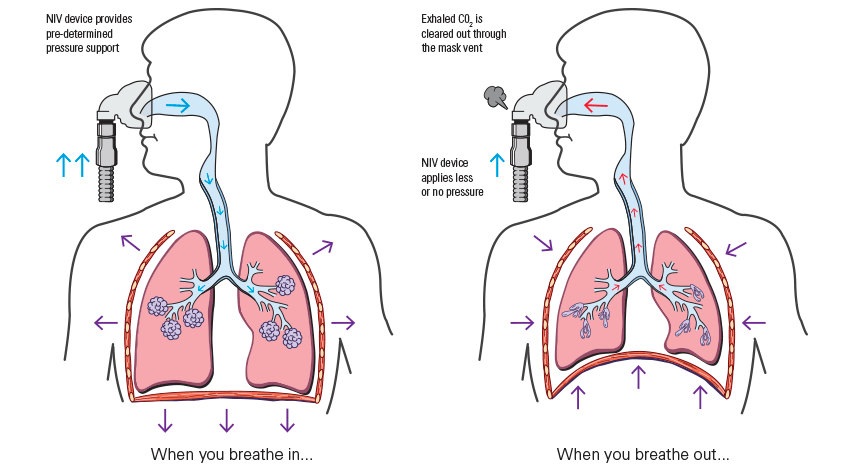Show me the way to...
txt
Show me the way to...
If you have chronic obstructive pulmonary disease (COPD), you may have trouble breathing properly. When you breathe in, your lungs may not absorb enough oxygen (O2), and when you breathe out, you may have trouble getting rid of the waste gas, carbon dioxide (CO2).
If you were in hospital, your doctor may have prescribed ventilation. This is to help your lungs exchange oxygen and carbon dioxide more efficiently. Your doctor may also decide that you need to keep on using ventilation at home if you have:
The most preferred type of ventilation in hospital and at home is non-invasive ventilation.
With non-invasive ventilation, you wear a mask that is attached via an air tube to a portable ventilator. You may be prescribed ventilation for use during sleep and during the day.

Non-invasive ventilation provides a number of benefits for certain COPD patients.
In the hospital, it can help by:
At home, it can help by:
Your doctor can advise whether home non-invasive ventilation is suitable for you.
Learn more about ResMed’s non-invasive ventilation solutions.
Ram F et al. Non-invasive positive pressure ventilation for treatment of respiratory failure due to exacerbations of chronic obstructive pulmonary disease. Cochrane Database Syst Rev. 2004;CD004104.
Galli JA et al. Home non-invasive ventilation use following acute hypercapnic respiratory failure in COPD. Respir Med. 2014;108(5):722-8.
Koehnlein T et al. Non-invasive positive pressure ventilation for the treatment of severe stable chronic obstructive pulmonary disease – A prospective, multicentre, randomized, controlled clinical trial. Lancet Respir Med. 2014;2:698-705.
Duiverman ML et al. Two-year home-based nocturnal non-invasive ventilation added to rehabilitation in chronic obstructive pulmonary disease. Respir Res. 2011;12(112).
Symptoms include build-up of mucus, cough and shortness of breath. Characterised by bronchitis ...
How is COPD diagnosed? How is COPD treated? Medication, exercise, oxygen and ventilation can ...
ResMed’s portable ventilators and comfortable masks have been widely used by COPD patients to ...
This webpage content is intended for Healthcare Professionals only, not for general public.
The content available through this website is for informational and educational purposes only and is not a substitute for the professional judgment of a health care professional in diagnosing and treating patients. ResMed does not give medical advice, nor does it provide medical or diagnostic services. Always seek the advice of a physician or other qualified health provider with any questions you may have regarding a medical condition. Never disregard professional medical advice or delay in seeking it because of something you have seen or read on this Website. For more information, please refer to our Terms of Use.
© ResMed. All rights reserved.